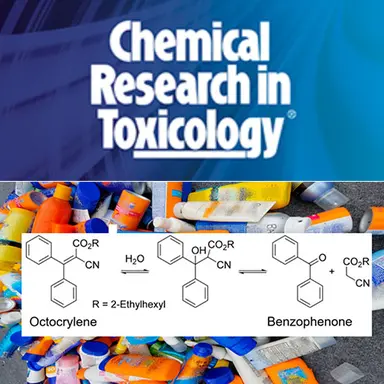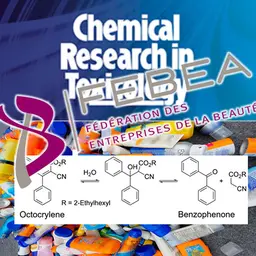
According to a scientific study published on 7 March 2021 in the Journal “Chemical Research in Toxicology”, Octocrylene contained in cosmetic products, particularly sunscreen products, degrades over time and generates Benzophenone, in proportions that may represent a risk to the safety and health of consumers. The authors of the study call on regulatory authorities to ban the manufacture and sale of products formulated with these two UV filters.
This study was carried out by researchers from the Laboratory of Biodiversity and Microbial Biotechnology of the Oceanological Observatory of Banyuls-sur-Mer (Sorbonne University/CNRS) in collaboration with the American Haereticus Environmental Laboratory.
Its aim was to assess whether:
• Benzophenone was present in many sun protection products (or displaying an SPF)
• The concentration of Benzophenone increased with time
• The degradation of Octocrylene could be a source of Benzophenone contamination
Study background
Octocrylene (CAS: 6197-30-4, EC: 228-250-8) is a UV filter and UV absorber currently authorised for up to 10% in cosmetic products, in Europe and across the Atlantic. It is also a protective agent against damage caused by light.
Benzophenone (CAS: 119-61-9, EC: 204-337-6) is a UV absorber and fragrance, not approved in the US and Canada. It is not regulated by Regulation 1223/2009 in Europe, but has been included in the list of 28 potential endocrine disruptors to be assessed as a priority: the industry has chosen not to present a dossier in defence of the substance, which should therefore be banned in the future. The substance has a potentially dangerous toxicological profile and is believed to be genotoxic, carcinogenic, an endocrine disruptor…
Benzophenone, a contaminant of Octocrylene
“The personal care product industry has known for some time that Octocrylene is contaminated with Benzophenone,” the authors of the study state. *“When purchasing raw Octocrylene for sunscreen or personal care product manufacturing, industry admits that Benzophenone is a contaminant found in Octocrylene and, for some reason, ‘cannot be removed by its entirety when Octocrylene is being processed’…*
However, the concentration of Benzophenone in ingredients made from Octocrylene and in products would be”negligible”. But according to Proposition 65 of the State of California, there is neither a safe level for Benzophenone nor an acceptable level of contamination in a product.
Octocrylene, a widely used filter
The other possibility for Benzophenone to end up in a product is that it is produced by a process of degradation of Octocrylene over time.
In this case, the authors of the study point out, “Octocrylene products potentially pose a serious health hazard.”
Well, in the US market alone, in 2019, they counted 2999 registrations of sunscreen products containing Octocrylene, which is also present in other types of products such as shampoos, hair sprays, conditioners, anti-ageing creams, moisturising lotions…
Study details
To carry out their tests, the researchers purchased in shops, in triplicate, nine products on the French market (including one without Octocrylene) and eight on the American market (with 4.5 to 10% Octocrylene in the formulation), as well as two samples of Octocrylene from two different suppliers of raw materials.
All finished products were tested directly after purchase (they represent products stored under normal conditions of use) and after being stored for six weeks in an incubator at 40°C with 75% relative humidity (which constitutes accelerated ageing equivalent to one year’s storage at room temperature).
Results
Benzophenone was detected in all finished products containing Octocrylene, but not in the only one that did not contain it.
In the first test, just after purchase, the levels detected ranged from 6 mg/kg to 186 mg/kg (average = 39 mg/kg).
After the accelerated ageing phase, the levels detected in the 16 products containing Octocrylene ranged from 9.8 mg/kg to 435 mg/kg (average = 75 mg/kg). Benzophenone, again, was not detected in the product not containing Octocrylene.
Both raw materials contained Benzophenone (151 mg/kg for one, 47.7 mg/kg for the other).
Conclusions
“Our work unambiguously establishes that octocrylene does undergo a slow retro-aldol condensation reaction that gives rise to benzophenone. This process occurred in all commercial sunscreens tested that contain octocrylene, resulting in the concomitant increase of the benzophenone concentration upon aging the product,” say the authors of the study.
They conclude that products containing Octocrylene may pose a threat to public and environmental health, and call for a “responsible regulatory response to prohibit the manufacture and sale of these octocrylene/benzophenone formulated products until industry can prove beyond a reasonable doubt that chronic exposure does not cause harm over any aspect…”
Related Ingredients Sheets
Source
• Benzophenone Accumulates over Time from the Degradation of Octocrylene in Commercial Sunscreen Products, C. A. Downs, Joseph C. DiNardo, Didier Stien, Alice M. S. Rodrigues, and Philippe Lebaron, Chem. Res. Toxicol. 2021





